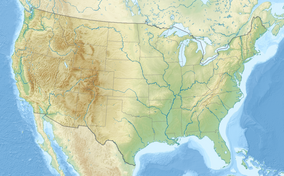Sand Creek Massacre National Historic Site
| Sand Creek Massacre National Historic Site | |
|---|---|
 The site, July 1985 | |
| Location | Kiowa County, Colorado, United States |
| Nearest city | Eads, CO |
| Coordinates | 38°32′27″N 102°31′43″W / 38.54083°N 102.52861°W |
| Area | 12,583 acres (50.92 km2)[1] |
| Established | April 27, 2007 |
| Visitors | 5,701 (in 2019)[2] |
| Governing body | National Park Service |
| Website | Sand Creek Massacre National Historic Site |
Sand Creek Massacre National Historic Site is a National Historic Site in Kiowa County, Colorado, commemorating the Sand Creek Massacre that occurred here on November 29, 1864. The site is considered sacred after the unprovoked assault on an encampment of approximately 750 Native people resulted in the murder of hundreds of men, women and children. Near Eads and Chivington, the site is about 170 miles (270 km) southeast of Denver and about 125 miles (200 km) east of Pueblo. A few basic park facilities have been opened at this site.
In 1999, archaeological teams from the National Park Service, Dept. of the Interior BLM, Colorado Historical Society and accompanied by Native American observers, made a major archaeological discovery of remains of the massacre site. Large numbers of period bullets, camp equipment, and other items convinced the NPS that they had found the correct site.

The Historic Site was authorized by Public Law 106-465 on November 7, 2000, in order to "recognize the national significance of the massacre in American history, and its ongoing significance to the Cheyenne and Arapaho people and the descendants of the massacre victims." The law authorized establishment of the site once the National Park Service acquired sufficient land from willing sellers to preserve, commemorate, and interpret the massacre. The site near the junction of County Road 54 and County Road "W" was listed on the National Register of Historic Places on September 28, 2001. The site contains a small visitor center, interpretive plaques and signage, monuments located on a hilltop overlooking the massacre site, and two walking trails.[3] The massacre site itself is off-limits to visitors.
On August 2, 2005, President George W. Bush gave final approval for the site. On April 23, 2007, it was announced that site would become America's 391st official park unit[4] with an effective date of April 27, 2007.[5] The dedication ceremony was held on April 28, 2007.[6] In October 2022, leaders from the Northern Arapaho Tribe, the Northern Cheyenne Tribe, the Cheyenne and Arapaho Tribes along with descendants of some of the massacre’s victims and survivors joined Secretary of the Interior Deb Haaland at the site as she announced the purchase of an additional 3,478 acres (1,407 ha).[7] The area included lands listed on the National Register of Historic Places for their significance. Archaeological remains include evidence of the village where Cheyenne and Arapaho families were camped, along with an intact viewshed that is key to the integrity of the site.[8] The expansion of the site contributed to one of the most intact shortgrass prairie ecosystems within the National Park system, providing habitat for a wide range of plants, wildlife and species of special concern.[9]
Currently, the site encompasses 12,583 acres (50.92 km2) of which 2,385 acres (9.65 km2) are federally owned.[1][needs update] By 2004, the federal government acquired 920 acres (3.7 km2) from private landowners. On September 9, 2006, the Cheyenne and Arapaho Tribes of Oklahoma conveyed to the United States title to 1,465 acres (6 km2) to be held in trust for the National Historic Site.[5] The site includes 640 acres (260 ha) acquired and preserved by the American Battlefield Trust and its partners.[10]
See also
[edit]References
[edit]![]() This article incorporates public domain material from websites or documents of the National Park Service.
This article incorporates public domain material from websites or documents of the National Park Service.
- ^ a b "Listing of acreage – December 31, 2011" (XLSX). Land Resource Division, National Park Service. Retrieved March 19, 2012. (National Park Service Acreage Reports)
- ^ "NPS Annual Recreation Visits Report". National Park Service. Retrieved March 19, 2012.
- ^ Sand Creek Massacre Site Pamphlet. Washington, D.C.: Government Printing Office. 2017.
- ^ U.S. Dept. of Interior. "Secretary Kempthorne Creates Sand Creek Massacre National Historic Site". Retrieved May 2, 2007.
- ^ a b Dirk Kempthorne. "Notice of Establishment of the Sand Creek Massacre National Historic Site". Federal Register Volume 72, Number 81, pp. 21048-21049. Archived from the original on August 18, 2017. Retrieved February 8, 2024.
- ^ National Park Service. "Sand Creek Massacre NHS Dedication, Schedule of Events" (PDF). Retrieved May 2, 2007.
- ^ Cooke, Kyle (October 5, 2022). "Sand Creek Massacre site expands by nearly 3,500 acres". Rocky Mountain PBS. Retrieved October 9, 2022.
- ^ Langmaid, Virginia (October 9, 2022). "The Sand Creek Massacre site will be expanded to preserve Native American tribes' sacred land". CNN. Retrieved October 9, 2022.
- ^ "Secretary Haaland Commits to Telling America's Story at Sand Creek Massacre National Historic Site" (Press release). October 5, 2022. Retrieved October 9, 2022.
- ^ [1] Land Saved by the American Battlefield Trust, accessed May 18, 2018.
External links
[edit]- Sand Creek Massacre Site National Register of Historic Places
- Sand Creek Massacre National Historic Site – National Park Service
- The Conservation Fund – Sand Creek Massacre National Historic Site

